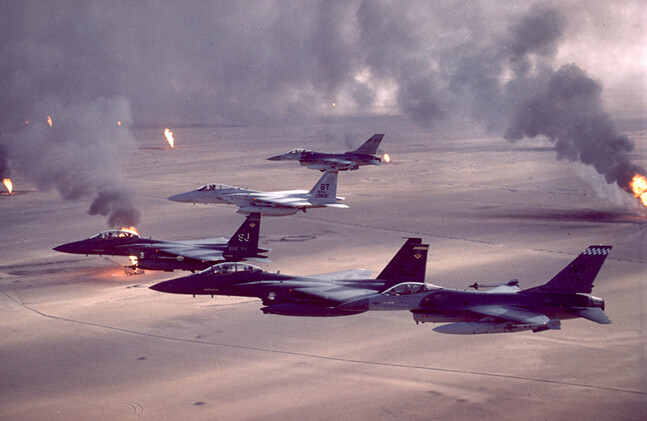I was sleeping in my tent in northern Saudi Arabia in the early morning hours of January 17, 1991, when the field telephone rang. It was my Intelligence Section informing me that the air war against Iraq had begun, and that Operation Desert Shield was now Operation Desert Storm. I did not know at the time that the entire air campaign had been kicked off by a group of Army Apache helicopters, commanded by my close friend and West Point classmate Lieutenant Colonel Dick Cody (later the vice chief of staff of the Army), and at first light I was pleased, as were my soldiers, to see a flight of Air Force F-16s flying low and slow over our position heading north. The soldiers cheered, the planes wagged their wings, and there were more than a few shouts of "Give 'em hell, Air Force!"
And the U.S. Air Force did give the Iraqi Armed Forces hell—for the next 37 days. They destroyed their integrated air defense system, their air bases, their command and control system, and their road and logistics network before turning their wrath on the Iraqi army itself, which dug into the sand as deeply as it could and dared not move. But, they couldn't run and they couldn't hide. American aircraft won every air-to-air engagement (things once called "dogfights"), and many Iraqi aircraft fled to Iran rather than face American and Allied pilots.
Nonetheless, after 37 days Baghdad had still not withdrawn from Kuwait. So the U.S. Army and Marine Corps went in to forcefully eject them. In a lightening 100-hour campaign against Saddam Hussein's army, American ground forces turned the Iraqi forces—the fourth largest army in the world at the time—into the second largest army in Iraq. As Council on Foreign Relations President Richard Haass recently wrote, Desert Storm was a tremendous success with lessons that should be carefully considered even regarding the current conditions in the Middle East that are substantially different. He is correct—as he usually is.
Why revisit this history from 25 years ago? Because it serves—or should serve—as a caution for those who oppose the nuclear weapons agreement with Iran (formally titled the Joint Comprehensive Plan of Action) that is currently being debated by the U.S. Congress. President Obama has described the nation's choice as being either accepting this agreement as a diplomatic solution or resorting to military force. Some opponents have said such a characterization is too stark, and the choice is between this deal and a better deal. But others argue that if there is no better deal, and no one has suggested a serious framework for one, then America's options are to just walk away or resort to military force to end Iranian nuclear ambitions. Some have suggested that a very brief air campaign of four to five days length would eliminate Tehran's nuclear program, and they use 1998's brief four-day Operation Desert Fox against Iraq as evidence.
The president has it right. There is no realistically feasible "better deal," and there is no brief air campaign that will end the Iranian nuclear program. Three dozen retired generals and admirals recently signed a letter supporting the agreement and declaring it a better option than military action. Why? Because these former officers understand both the limitations, and the potential for unintended consequences, of military action. Moreover, with most having recent experience, they have absorbed the intimate lessons of military operations from the past decade, actions that demonstrated greater political passion than military realism. In short, they clearly see that the benefits of such a campaign are doubtful while the costs are certain.
The Desert Storm air campaign, a classic application of air power, took weeks, was flown by aircraft from a coalition of over 30 countries, was directed against a country of relatively small geographical size, and focused on mostly soft targets of known location and function. During its duration, 65,000 sorties were flown—meaning nearly 70 aircraft took off on a mission every hour for six weeks. There were hundreds of aircraft involved operating from numerous bases. The Desert Fox campaign, by contrast, had no such scale, and was designed to intimidate the Iraqi leadership, which it seemingly did, but it was not intended to destroy a definitive military capability.
One does not need to be an experienced air campaigner to grasp a few essential facts. First, the attack assets available to American air forces today, although considerably more capable than those of 1991, are much smaller in number. For example, the U.S. Air Force that carried the bulk of the load during Desert Storm had nearly 10,000 aircraft. Today's Air Force has less than 6,000. In addition, the Air Force's attack assets—its fighters and bombers—are only half that of 1991. Reductions in Navy and Marine Corps aviation have been smaller, but still significant. In simple terms, the United States would be conducting an air campaign against a country nearly four times larger than Iraq with only half the air assets of Desert Storm. Moreover, there is no large inventory of allied aircraft to reinforce the mission and distribute the burdens. By any measure, far fewer aircraft will have to operate in a far larger area.
Second, the targets attacked in both Desert Storm and Desert Fox were relatively concentrated, well-known, and—as the military calls them—"soft." The Iranian nuclear target set is much different. In addition to being more numerous and widely dispersed, the locations of the targets may not be precisely known—and by "precisely known" one means within a matter of feet.
Individually, today's aircraft are more effective than ever before because they are more heavily armed with precision weapons. But precision weapons require precision intelligence, and the nation's 2003 record regarding the location of Iraqi WMD (weapons of mass destruction) is not encouraging. What we do know, however, is that the Iranian facilities will be buried and hardened, requiring attack by large, precision munitions. Employing these weapons requires a much higher degree of sophisticated targeting than that needed to drop a bridge, demolish a building, collapse a radio tower, or crater a runway.
Third, it can be expected that the Iranians will offer a spirited resistance requiring preliminary attacks. At the very least this means mounting missions against Iranian airfields, naval bases, command and control centers, and transportation networks that will be at least as intricate as those of Desert Storm. Conducting such a campaign—and it will require a campaign—requires detailed, sophisticated planning. During the Cold War era, the U.S. Air Force had elaborate planning cells practiced in designing such campaigns, but that has not been the Air Force experience over the past decade, where efforts have been much more tactical than operational or strategic. Make no mistake: if given this mission the U.S. Air Force will succeed. It will do what it is asked to do as well as it can, as there is no question anywhere that the United States has the best air forces in the world. But such an effort will not be quick, it will not be easy, and—given that the targets are nuclear facilities—it may not be clean.
Finally, the benefits of such an enormous effort are unclear, but the costs are nearly certain. Following such an intensive attack, the political strength and prestige of the Iranian regime would be increased. Although divided on many things, it can be expected that the Iranian people would rally to the support of their theocratic leadership, setting back for decades any hopes of a more pluralistic and moderate government. Iran would likely also resort to what was once called "horizontal escalation." In other words, the Ayatollahs would likely move quickly to create trouble elsewhere across the Middle East and possibly in the United States itself.
Of particular note: whereas Iraq has a 70-mile coastline at the upper end of the Arabian Gulf, Iran has a coast line 10 times longer that borders the entire north shore of the gulf, contains numerous naval bases, and sets astride the strategic Straits of Hormuz through which a large portion of internationally traded oil passes. For a region already roiled with messy conflicts that the Western powers are struggling to address, exponentially adding to the existing morass is far from wise military and diplomatic policy.
After over two years of negotiations between Iran and the P5+1 (the five permanent members of the UN Security Council plus Germany), the negotiated deal is as much as should be expected. It stops the Iranian program, installs an inspections and verification regime, and lifts economic sanctions on Iran. Some say the choice is between this deal and a "better" deal. But the better deal they suggest is not one that Tehran will likely embrace, and has conditions it has rejected during three years of negotiations. Some argue that Iran would be pressured to sign a better deal if the sanctions regime remained in place. But, as Richard Haass points out, over time sanctions regimes fray and leak, and in this case a U.S. rejection of the deal would likely leave it the lone participant in any residual sanctions effort, meaning the sanctions would be ineffective or quickly collapse.
Those retired military officers who signed their letter supporting acceptance of the Iranian nuclear agreement fully understand the conditions and calculus involved. They realize that references by some to the 1981 Israeli attack on the Osirak reactor in Iraq, the 2007 presumed Israeli attack on a facility in Syria, and Operation Desert Fox in 1998, are not representative of the scale, challenges, or consequences that would almost certainly accompany an attack on Iran.
During the Cuban missile crisis, President Kennedy stated in announcing the naval blockade, "The path we have chosen for the present is full of hazards, as all paths are—but it is the one most consistent with our character and courage as a nation and our commitments around the world." Many of the president's advisors were encouraging an air attack on Cuba to destroy the missile sites, but Kennedy knew what a military attack might do, as well as what it might cause. He knew the blockade would not remove the Soviet missiles—which it didn't. But he believed it would change Soviet behavior—which it did. He had performed the cost-benefit analysis, and he had the courage to make the wise choice. Today's leaders need to conduct a similar analysis, and then show similar courage.



